Fundamentals of Economics: Advantages of Increasing Tobacco Excise Duty Tax for Government
VerifiedAdded on 2023/01/11
|9
|2635
|20
AI Summary
This report discusses the advantages of increasing tobacco excise duty tax for the government, including the impact on tobacco consumption and revenue generation. It also explores the main determinants of price elasticity of demand for tobacco products and why poor smokers are more price sensitive than the rich.
Contribute Materials
Your contribution can guide someone’s learning journey. Share your
documents today.
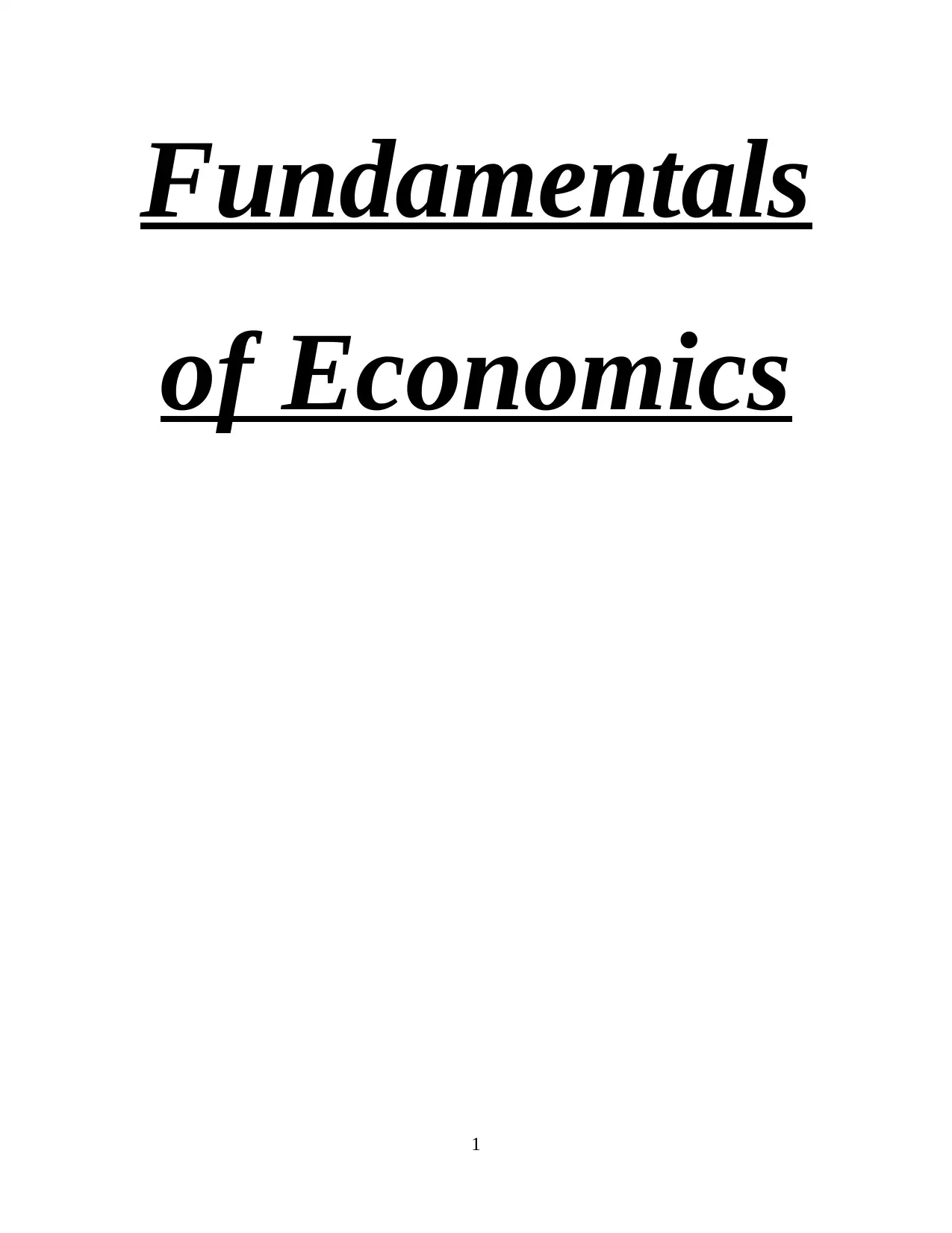
Fundamentals
of Economics
1
of Economics
1
Secure Best Marks with AI Grader
Need help grading? Try our AI Grader for instant feedback on your assignments.

INTRODUCTION...........................................................................................................................3
MAIN BODY..................................................................................................................................3
1. Advantages of increasing tobacco excise duty tax for government........................................3
2. Justify that governments to levy extra taxes on tobacco.........................................................4
3. Main determinants of the price elasticity of demand for tobacco products and why are poor
smokers more price sensitive than the rich..................................................................................6
4. Calculate the price elasticity of demand..................................................................................7
5. What long-term strategy might a global tobacco company should adopt...............................7
CONCLUSION................................................................................................................................8
REFERENCES................................................................................................................................9
2
MAIN BODY..................................................................................................................................3
1. Advantages of increasing tobacco excise duty tax for government........................................3
2. Justify that governments to levy extra taxes on tobacco.........................................................4
3. Main determinants of the price elasticity of demand for tobacco products and why are poor
smokers more price sensitive than the rich..................................................................................6
4. Calculate the price elasticity of demand..................................................................................7
5. What long-term strategy might a global tobacco company should adopt...............................7
CONCLUSION................................................................................................................................8
REFERENCES................................................................................................................................9
2
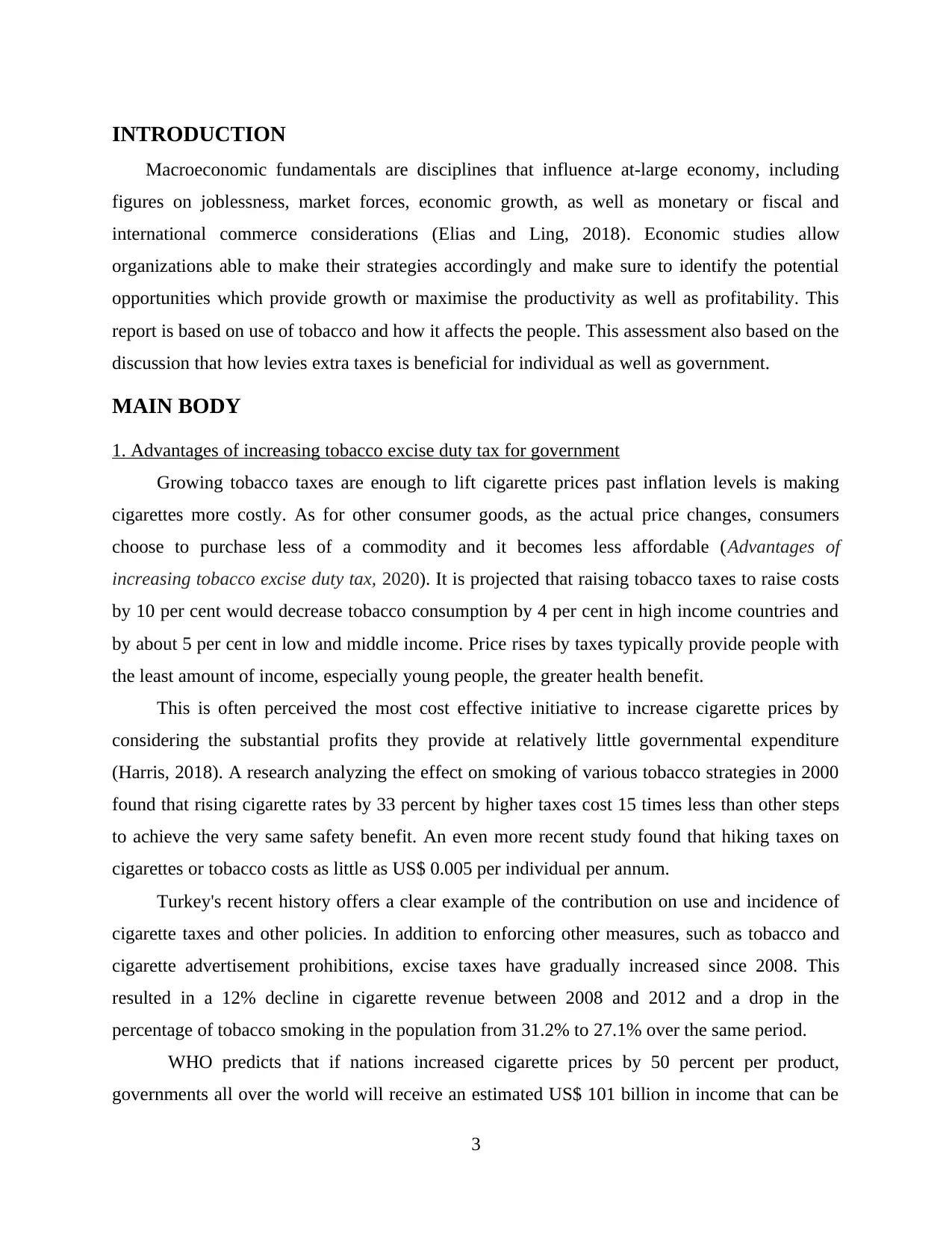
INTRODUCTION
Macroeconomic fundamentals are disciplines that influence at-large economy, including
figures on joblessness, market forces, economic growth, as well as monetary or fiscal and
international commerce considerations (Elias and Ling, 2018). Economic studies allow
organizations able to make their strategies accordingly and make sure to identify the potential
opportunities which provide growth or maximise the productivity as well as profitability. This
report is based on use of tobacco and how it affects the people. This assessment also based on the
discussion that how levies extra taxes is beneficial for individual as well as government.
MAIN BODY
1. Advantages of increasing tobacco excise duty tax for government
Growing tobacco taxes are enough to lift cigarette prices past inflation levels is making
cigarettes more costly. As for other consumer goods, as the actual price changes, consumers
choose to purchase less of a commodity and it becomes less affordable (Advantages of
increasing tobacco excise duty tax, 2020). It is projected that raising tobacco taxes to raise costs
by 10 per cent would decrease tobacco consumption by 4 per cent in high income countries and
by about 5 per cent in low and middle income. Price rises by taxes typically provide people with
the least amount of income, especially young people, the greater health benefit.
This is often perceived the most cost effective initiative to increase cigarette prices by
considering the substantial profits they provide at relatively little governmental expenditure
(Harris, 2018). A research analyzing the effect on smoking of various tobacco strategies in 2000
found that rising cigarette rates by 33 percent by higher taxes cost 15 times less than other steps
to achieve the very same safety benefit. An even more recent study found that hiking taxes on
cigarettes or tobacco costs as little as US$ 0.005 per individual per annum.
Turkey's recent history offers a clear example of the contribution on use and incidence of
cigarette taxes and other policies. In addition to enforcing other measures, such as tobacco and
cigarette advertisement prohibitions, excise taxes have gradually increased since 2008. This
resulted in a 12% decline in cigarette revenue between 2008 and 2012 and a drop in the
percentage of tobacco smoking in the population from 31.2% to 27.1% over the same period.
WHO predicts that if nations increased cigarette prices by 50 percent per product,
governments all over the world will receive an estimated US$ 101 billion in income that can be
3
Macroeconomic fundamentals are disciplines that influence at-large economy, including
figures on joblessness, market forces, economic growth, as well as monetary or fiscal and
international commerce considerations (Elias and Ling, 2018). Economic studies allow
organizations able to make their strategies accordingly and make sure to identify the potential
opportunities which provide growth or maximise the productivity as well as profitability. This
report is based on use of tobacco and how it affects the people. This assessment also based on the
discussion that how levies extra taxes is beneficial for individual as well as government.
MAIN BODY
1. Advantages of increasing tobacco excise duty tax for government
Growing tobacco taxes are enough to lift cigarette prices past inflation levels is making
cigarettes more costly. As for other consumer goods, as the actual price changes, consumers
choose to purchase less of a commodity and it becomes less affordable (Advantages of
increasing tobacco excise duty tax, 2020). It is projected that raising tobacco taxes to raise costs
by 10 per cent would decrease tobacco consumption by 4 per cent in high income countries and
by about 5 per cent in low and middle income. Price rises by taxes typically provide people with
the least amount of income, especially young people, the greater health benefit.
This is often perceived the most cost effective initiative to increase cigarette prices by
considering the substantial profits they provide at relatively little governmental expenditure
(Harris, 2018). A research analyzing the effect on smoking of various tobacco strategies in 2000
found that rising cigarette rates by 33 percent by higher taxes cost 15 times less than other steps
to achieve the very same safety benefit. An even more recent study found that hiking taxes on
cigarettes or tobacco costs as little as US$ 0.005 per individual per annum.
Turkey's recent history offers a clear example of the contribution on use and incidence of
cigarette taxes and other policies. In addition to enforcing other measures, such as tobacco and
cigarette advertisement prohibitions, excise taxes have gradually increased since 2008. This
resulted in a 12% decline in cigarette revenue between 2008 and 2012 and a drop in the
percentage of tobacco smoking in the population from 31.2% to 27.1% over the same period.
WHO predicts that if nations increased cigarette prices by 50 percent per product,
governments all over the world will receive an estimated US$ 101 billion in income that can be
3
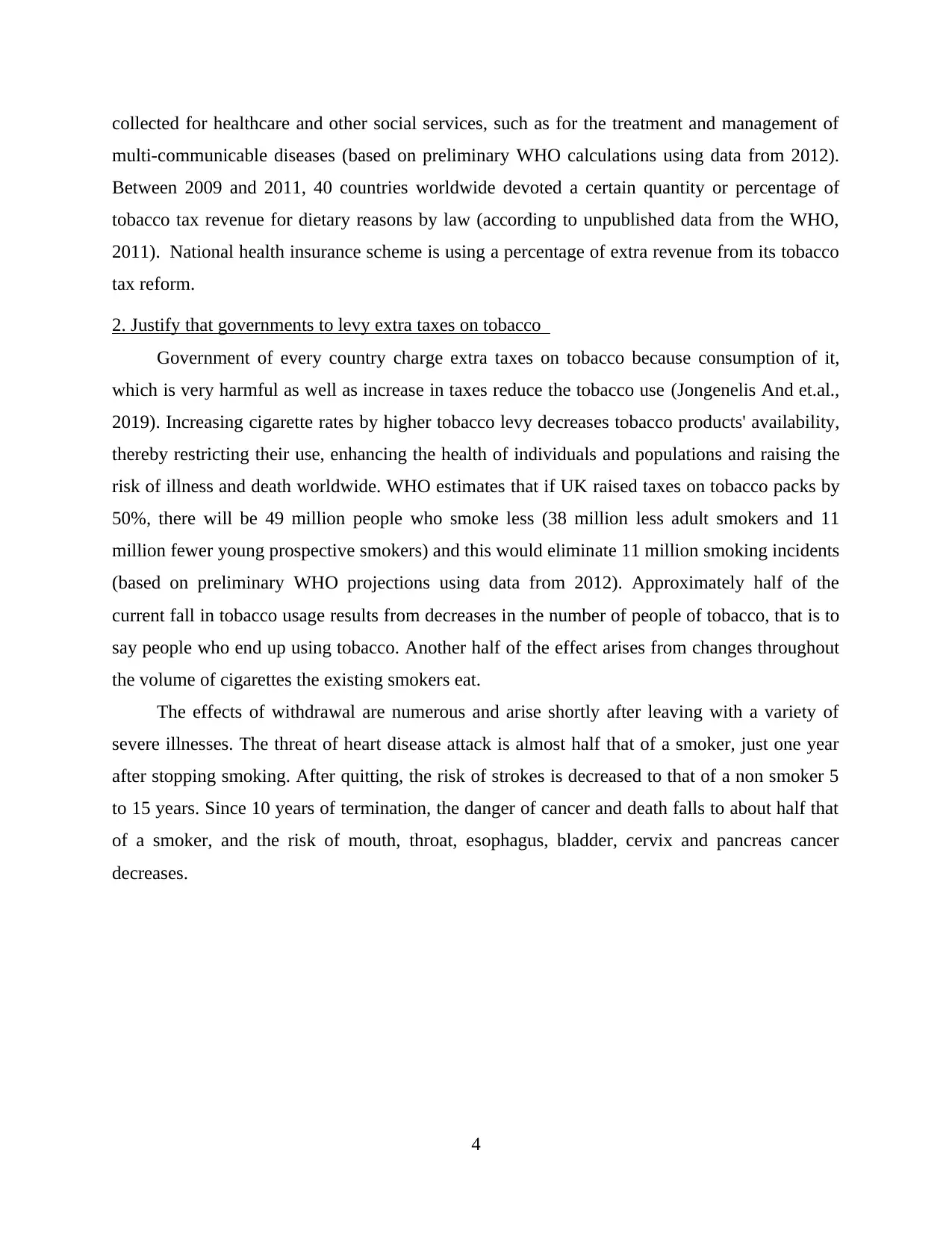
collected for healthcare and other social services, such as for the treatment and management of
multi-communicable diseases (based on preliminary WHO calculations using data from 2012).
Between 2009 and 2011, 40 countries worldwide devoted a certain quantity or percentage of
tobacco tax revenue for dietary reasons by law (according to unpublished data from the WHO,
2011). National health insurance scheme is using a percentage of extra revenue from its tobacco
tax reform.
2. Justify that governments to levy extra taxes on tobacco
Government of every country charge extra taxes on tobacco because consumption of it,
which is very harmful as well as increase in taxes reduce the tobacco use (Jongenelis And et.al.,
2019). Increasing cigarette rates by higher tobacco levy decreases tobacco products' availability,
thereby restricting their use, enhancing the health of individuals and populations and raising the
risk of illness and death worldwide. WHO estimates that if UK raised taxes on tobacco packs by
50%, there will be 49 million people who smoke less (38 million less adult smokers and 11
million fewer young prospective smokers) and this would eliminate 11 million smoking incidents
(based on preliminary WHO projections using data from 2012). Approximately half of the
current fall in tobacco usage results from decreases in the number of people of tobacco, that is to
say people who end up using tobacco. Another half of the effect arises from changes throughout
the volume of cigarettes the existing smokers eat.
The effects of withdrawal are numerous and arise shortly after leaving with a variety of
severe illnesses. The threat of heart disease attack is almost half that of a smoker, just one year
after stopping smoking. After quitting, the risk of strokes is decreased to that of a non smoker 5
to 15 years. Since 10 years of termination, the danger of cancer and death falls to about half that
of a smoker, and the risk of mouth, throat, esophagus, bladder, cervix and pancreas cancer
decreases.
4
multi-communicable diseases (based on preliminary WHO calculations using data from 2012).
Between 2009 and 2011, 40 countries worldwide devoted a certain quantity or percentage of
tobacco tax revenue for dietary reasons by law (according to unpublished data from the WHO,
2011). National health insurance scheme is using a percentage of extra revenue from its tobacco
tax reform.
2. Justify that governments to levy extra taxes on tobacco
Government of every country charge extra taxes on tobacco because consumption of it,
which is very harmful as well as increase in taxes reduce the tobacco use (Jongenelis And et.al.,
2019). Increasing cigarette rates by higher tobacco levy decreases tobacco products' availability,
thereby restricting their use, enhancing the health of individuals and populations and raising the
risk of illness and death worldwide. WHO estimates that if UK raised taxes on tobacco packs by
50%, there will be 49 million people who smoke less (38 million less adult smokers and 11
million fewer young prospective smokers) and this would eliminate 11 million smoking incidents
(based on preliminary WHO projections using data from 2012). Approximately half of the
current fall in tobacco usage results from decreases in the number of people of tobacco, that is to
say people who end up using tobacco. Another half of the effect arises from changes throughout
the volume of cigarettes the existing smokers eat.
The effects of withdrawal are numerous and arise shortly after leaving with a variety of
severe illnesses. The threat of heart disease attack is almost half that of a smoker, just one year
after stopping smoking. After quitting, the risk of strokes is decreased to that of a non smoker 5
to 15 years. Since 10 years of termination, the danger of cancer and death falls to about half that
of a smoker, and the risk of mouth, throat, esophagus, bladder, cervix and pancreas cancer
decreases.
4
Secure Best Marks with AI Grader
Need help grading? Try our AI Grader for instant feedback on your assignments.
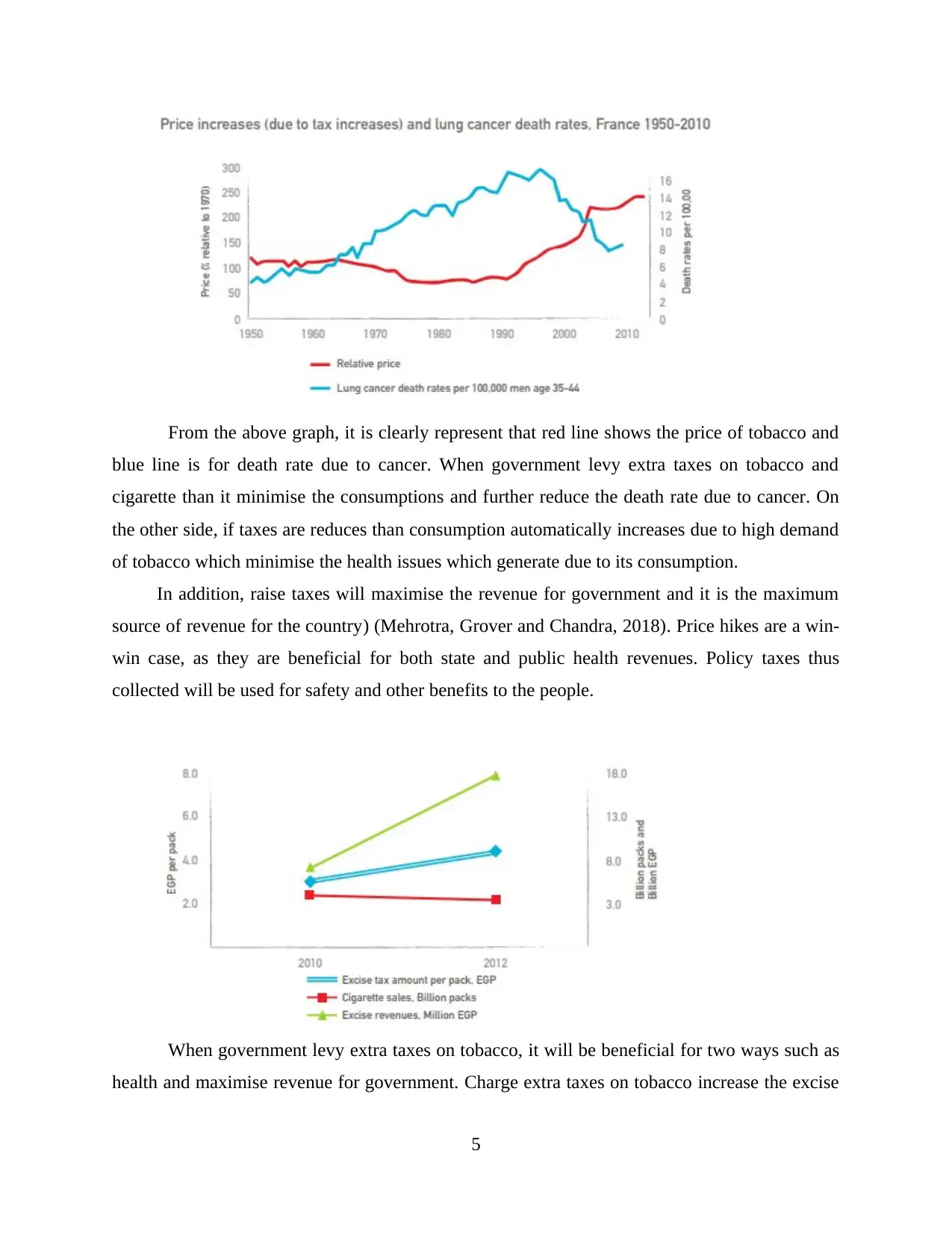
From the above graph, it is clearly represent that red line shows the price of tobacco and
blue line is for death rate due to cancer. When government levy extra taxes on tobacco and
cigarette than it minimise the consumptions and further reduce the death rate due to cancer. On
the other side, if taxes are reduces than consumption automatically increases due to high demand
of tobacco which minimise the health issues which generate due to its consumption.
In addition, raise taxes will maximise the revenue for government and it is the maximum
source of revenue for the country) (Mehrotra, Grover and Chandra, 2018). Price hikes are a win-
win case, as they are beneficial for both state and public health revenues. Policy taxes thus
collected will be used for safety and other benefits to the people.
When government levy extra taxes on tobacco, it will be beneficial for two ways such as
health and maximise revenue for government. Charge extra taxes on tobacco increase the excise
5
blue line is for death rate due to cancer. When government levy extra taxes on tobacco and
cigarette than it minimise the consumptions and further reduce the death rate due to cancer. On
the other side, if taxes are reduces than consumption automatically increases due to high demand
of tobacco which minimise the health issues which generate due to its consumption.
In addition, raise taxes will maximise the revenue for government and it is the maximum
source of revenue for the country) (Mehrotra, Grover and Chandra, 2018). Price hikes are a win-
win case, as they are beneficial for both state and public health revenues. Policy taxes thus
collected will be used for safety and other benefits to the people.
When government levy extra taxes on tobacco, it will be beneficial for two ways such as
health and maximise revenue for government. Charge extra taxes on tobacco increase the excise
5
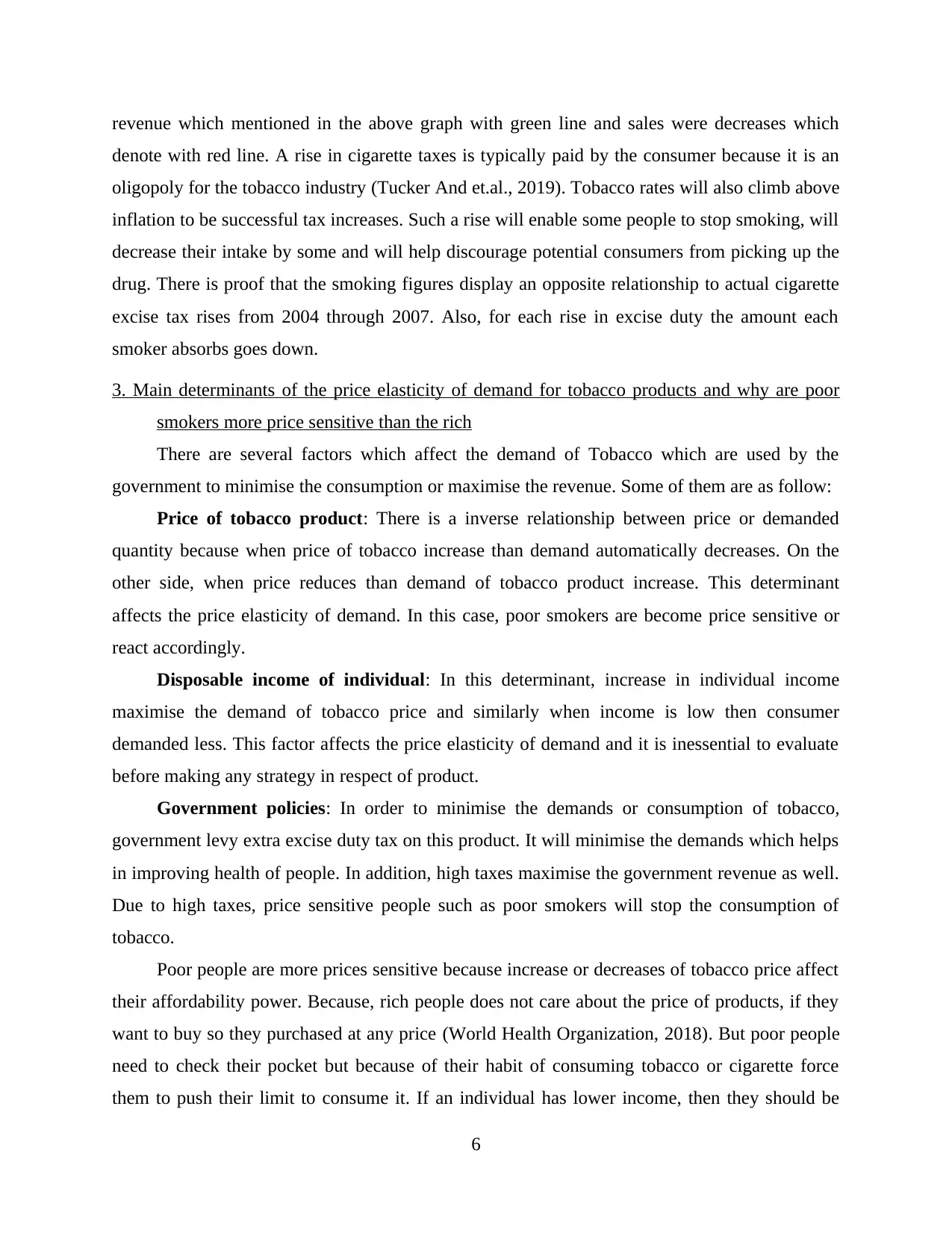
revenue which mentioned in the above graph with green line and sales were decreases which
denote with red line. A rise in cigarette taxes is typically paid by the consumer because it is an
oligopoly for the tobacco industry (Tucker And et.al., 2019). Tobacco rates will also climb above
inflation to be successful tax increases. Such a rise will enable some people to stop smoking, will
decrease their intake by some and will help discourage potential consumers from picking up the
drug. There is proof that the smoking figures display an opposite relationship to actual cigarette
excise tax rises from 2004 through 2007. Also, for each rise in excise duty the amount each
smoker absorbs goes down.
3. Main determinants of the price elasticity of demand for tobacco products and why are poor
smokers more price sensitive than the rich
There are several factors which affect the demand of Tobacco which are used by the
government to minimise the consumption or maximise the revenue. Some of them are as follow:
Price of tobacco product: There is a inverse relationship between price or demanded
quantity because when price of tobacco increase than demand automatically decreases. On the
other side, when price reduces than demand of tobacco product increase. This determinant
affects the price elasticity of demand. In this case, poor smokers are become price sensitive or
react accordingly.
Disposable income of individual: In this determinant, increase in individual income
maximise the demand of tobacco price and similarly when income is low then consumer
demanded less. This factor affects the price elasticity of demand and it is inessential to evaluate
before making any strategy in respect of product.
Government policies: In order to minimise the demands or consumption of tobacco,
government levy extra excise duty tax on this product. It will minimise the demands which helps
in improving health of people. In addition, high taxes maximise the government revenue as well.
Due to high taxes, price sensitive people such as poor smokers will stop the consumption of
tobacco.
Poor people are more prices sensitive because increase or decreases of tobacco price affect
their affordability power. Because, rich people does not care about the price of products, if they
want to buy so they purchased at any price (World Health Organization, 2018). But poor people
need to check their pocket but because of their habit of consuming tobacco or cigarette force
them to push their limit to consume it. If an individual has lower income, then they should be
6
denote with red line. A rise in cigarette taxes is typically paid by the consumer because it is an
oligopoly for the tobacco industry (Tucker And et.al., 2019). Tobacco rates will also climb above
inflation to be successful tax increases. Such a rise will enable some people to stop smoking, will
decrease their intake by some and will help discourage potential consumers from picking up the
drug. There is proof that the smoking figures display an opposite relationship to actual cigarette
excise tax rises from 2004 through 2007. Also, for each rise in excise duty the amount each
smoker absorbs goes down.
3. Main determinants of the price elasticity of demand for tobacco products and why are poor
smokers more price sensitive than the rich
There are several factors which affect the demand of Tobacco which are used by the
government to minimise the consumption or maximise the revenue. Some of them are as follow:
Price of tobacco product: There is a inverse relationship between price or demanded
quantity because when price of tobacco increase than demand automatically decreases. On the
other side, when price reduces than demand of tobacco product increase. This determinant
affects the price elasticity of demand. In this case, poor smokers are become price sensitive or
react accordingly.
Disposable income of individual: In this determinant, increase in individual income
maximise the demand of tobacco price and similarly when income is low then consumer
demanded less. This factor affects the price elasticity of demand and it is inessential to evaluate
before making any strategy in respect of product.
Government policies: In order to minimise the demands or consumption of tobacco,
government levy extra excise duty tax on this product. It will minimise the demands which helps
in improving health of people. In addition, high taxes maximise the government revenue as well.
Due to high taxes, price sensitive people such as poor smokers will stop the consumption of
tobacco.
Poor people are more prices sensitive because increase or decreases of tobacco price affect
their affordability power. Because, rich people does not care about the price of products, if they
want to buy so they purchased at any price (World Health Organization, 2018). But poor people
need to check their pocket but because of their habit of consuming tobacco or cigarette force
them to push their limit to consume it. If an individual has lower income, then they should be
6
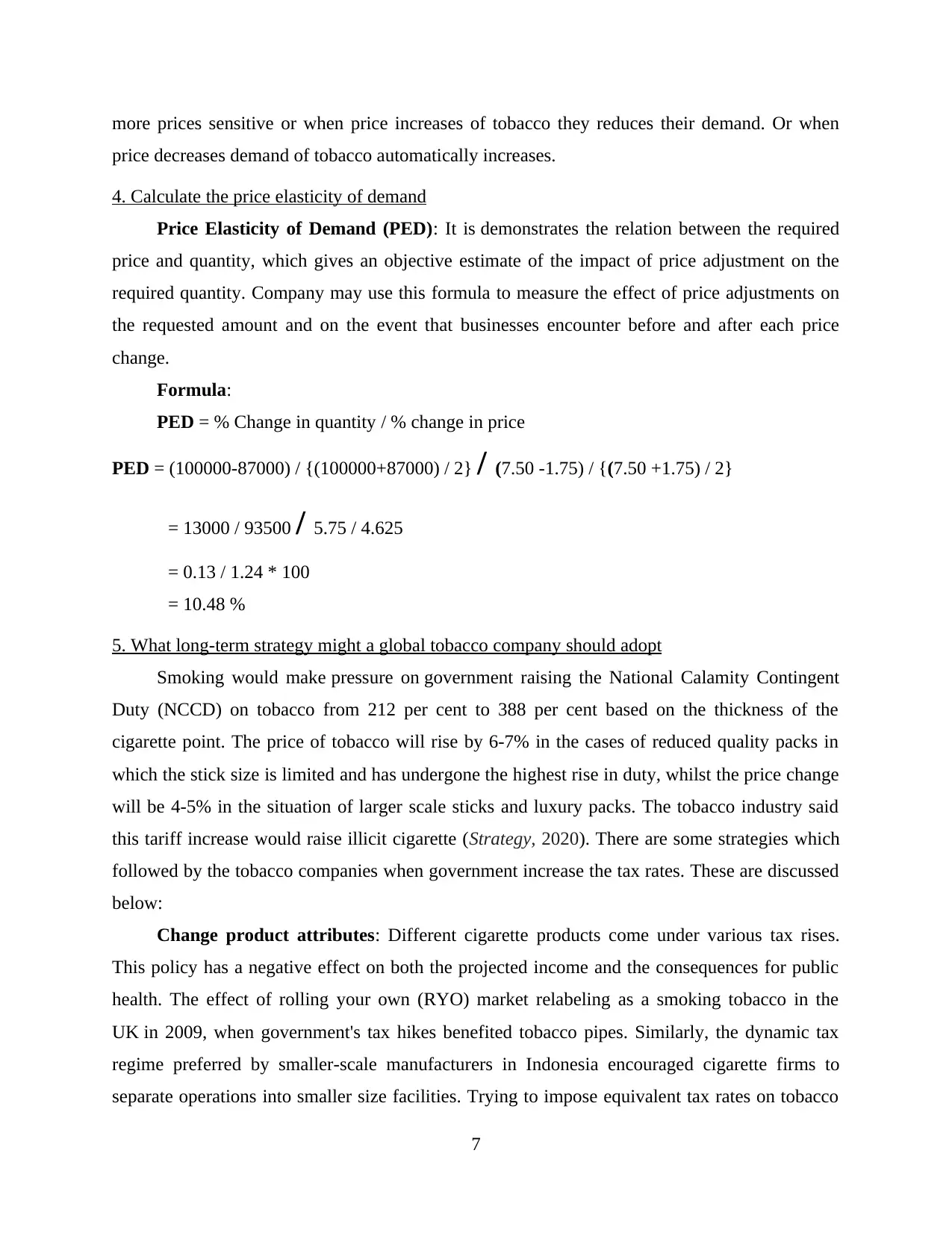
more prices sensitive or when price increases of tobacco they reduces their demand. Or when
price decreases demand of tobacco automatically increases.
4. Calculate the price elasticity of demand
Price Elasticity of Demand (PED): It is demonstrates the relation between the required
price and quantity, which gives an objective estimate of the impact of price adjustment on the
required quantity. Company may use this formula to measure the effect of price adjustments on
the requested amount and on the event that businesses encounter before and after each price
change.
Formula:
PED = % Change in quantity / % change in price
PED = (100000-87000) / {(100000+87000) / 2} / (7.50 -1.75) / {(7.50 +1.75) / 2}
= 13000 / 93500 / 5.75 / 4.625
= 0.13 / 1.24 * 100
= 10.48 %
5. What long-term strategy might a global tobacco company should adopt
Smoking would make pressure on government raising the National Calamity Contingent
Duty (NCCD) on tobacco from 212 per cent to 388 per cent based on the thickness of the
cigarette point. The price of tobacco will rise by 6-7% in the cases of reduced quality packs in
which the stick size is limited and has undergone the highest rise in duty, whilst the price change
will be 4-5% in the situation of larger scale sticks and luxury packs. The tobacco industry said
this tariff increase would raise illicit cigarette (Strategy, 2020). There are some strategies which
followed by the tobacco companies when government increase the tax rates. These are discussed
below:
Change product attributes: Different cigarette products come under various tax rises.
This policy has a negative effect on both the projected income and the consequences for public
health. The effect of rolling your own (RYO) market relabeling as a smoking tobacco in the
UK in 2009, when government's tax hikes benefited tobacco pipes. Similarly, the dynamic tax
regime preferred by smaller-scale manufacturers in Indonesia encouraged cigarette firms to
separate operations into smaller size facilities. Trying to impose equivalent tax rates on tobacco
7
price decreases demand of tobacco automatically increases.
4. Calculate the price elasticity of demand
Price Elasticity of Demand (PED): It is demonstrates the relation between the required
price and quantity, which gives an objective estimate of the impact of price adjustment on the
required quantity. Company may use this formula to measure the effect of price adjustments on
the requested amount and on the event that businesses encounter before and after each price
change.
Formula:
PED = % Change in quantity / % change in price
PED = (100000-87000) / {(100000+87000) / 2} / (7.50 -1.75) / {(7.50 +1.75) / 2}
= 13000 / 93500 / 5.75 / 4.625
= 0.13 / 1.24 * 100
= 10.48 %
5. What long-term strategy might a global tobacco company should adopt
Smoking would make pressure on government raising the National Calamity Contingent
Duty (NCCD) on tobacco from 212 per cent to 388 per cent based on the thickness of the
cigarette point. The price of tobacco will rise by 6-7% in the cases of reduced quality packs in
which the stick size is limited and has undergone the highest rise in duty, whilst the price change
will be 4-5% in the situation of larger scale sticks and luxury packs. The tobacco industry said
this tariff increase would raise illicit cigarette (Strategy, 2020). There are some strategies which
followed by the tobacco companies when government increase the tax rates. These are discussed
below:
Change product attributes: Different cigarette products come under various tax rises.
This policy has a negative effect on both the projected income and the consequences for public
health. The effect of rolling your own (RYO) market relabeling as a smoking tobacco in the
UK in 2009, when government's tax hikes benefited tobacco pipes. Similarly, the dynamic tax
regime preferred by smaller-scale manufacturers in Indonesia encouraged cigarette firms to
separate operations into smaller size facilities. Trying to impose equivalent tax rates on tobacco
7
Paraphrase This Document
Need a fresh take? Get an instant paraphrase of this document with our AI Paraphraser
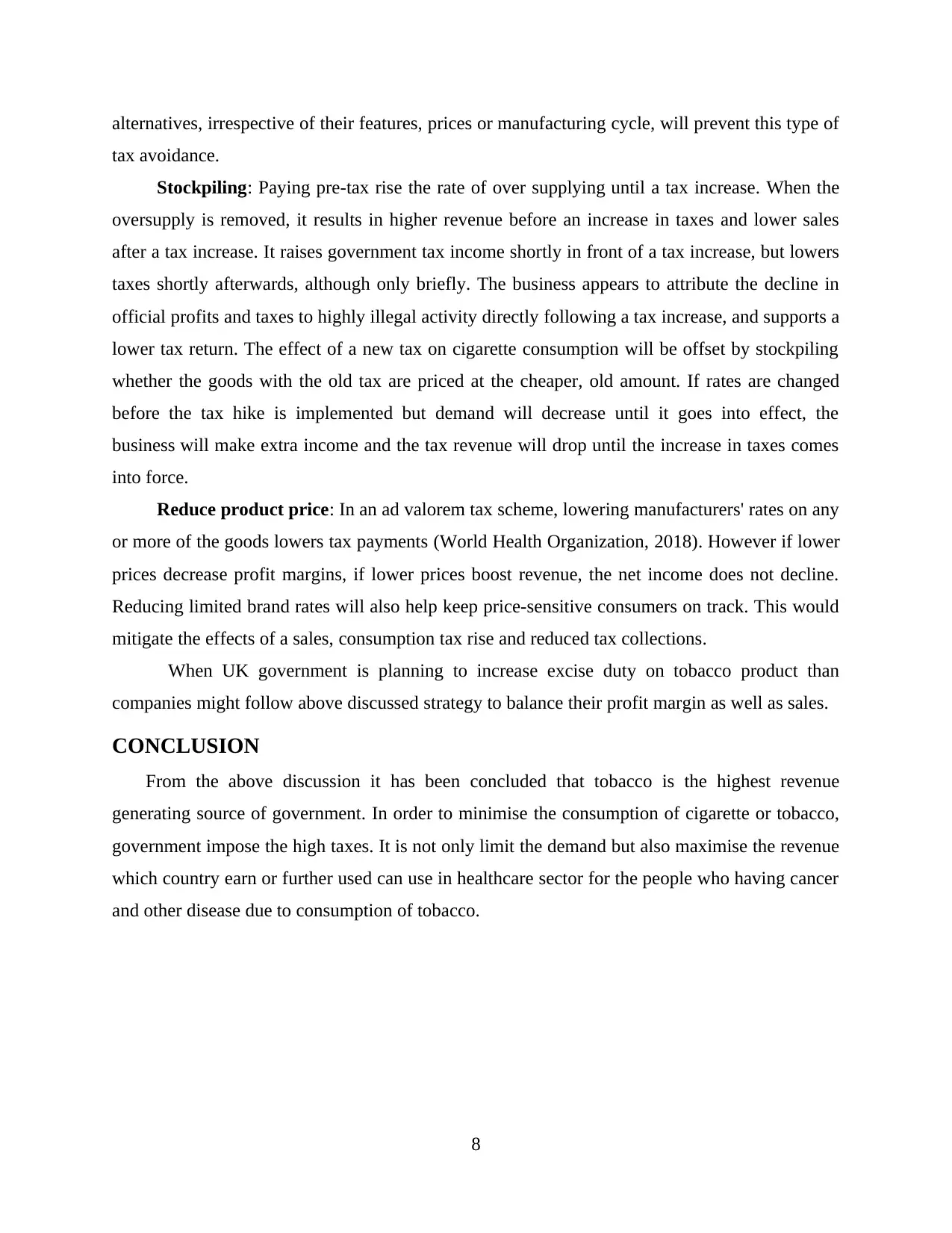
alternatives, irrespective of their features, prices or manufacturing cycle, will prevent this type of
tax avoidance.
Stockpiling: Paying pre-tax rise the rate of over supplying until a tax increase. When the
oversupply is removed, it results in higher revenue before an increase in taxes and lower sales
after a tax increase. It raises government tax income shortly in front of a tax increase, but lowers
taxes shortly afterwards, although only briefly. The business appears to attribute the decline in
official profits and taxes to highly illegal activity directly following a tax increase, and supports a
lower tax return. The effect of a new tax on cigarette consumption will be offset by stockpiling
whether the goods with the old tax are priced at the cheaper, old amount. If rates are changed
before the tax hike is implemented but demand will decrease until it goes into effect, the
business will make extra income and the tax revenue will drop until the increase in taxes comes
into force.
Reduce product price: In an ad valorem tax scheme, lowering manufacturers' rates on any
or more of the goods lowers tax payments (World Health Organization, 2018). However if lower
prices decrease profit margins, if lower prices boost revenue, the net income does not decline.
Reducing limited brand rates will also help keep price-sensitive consumers on track. This would
mitigate the effects of a sales, consumption tax rise and reduced tax collections.
When UK government is planning to increase excise duty on tobacco product than
companies might follow above discussed strategy to balance their profit margin as well as sales.
CONCLUSION
From the above discussion it has been concluded that tobacco is the highest revenue
generating source of government. In order to minimise the consumption of cigarette or tobacco,
government impose the high taxes. It is not only limit the demand but also maximise the revenue
which country earn or further used can use in healthcare sector for the people who having cancer
and other disease due to consumption of tobacco.
8
tax avoidance.
Stockpiling: Paying pre-tax rise the rate of over supplying until a tax increase. When the
oversupply is removed, it results in higher revenue before an increase in taxes and lower sales
after a tax increase. It raises government tax income shortly in front of a tax increase, but lowers
taxes shortly afterwards, although only briefly. The business appears to attribute the decline in
official profits and taxes to highly illegal activity directly following a tax increase, and supports a
lower tax return. The effect of a new tax on cigarette consumption will be offset by stockpiling
whether the goods with the old tax are priced at the cheaper, old amount. If rates are changed
before the tax hike is implemented but demand will decrease until it goes into effect, the
business will make extra income and the tax revenue will drop until the increase in taxes comes
into force.
Reduce product price: In an ad valorem tax scheme, lowering manufacturers' rates on any
or more of the goods lowers tax payments (World Health Organization, 2018). However if lower
prices decrease profit margins, if lower prices boost revenue, the net income does not decline.
Reducing limited brand rates will also help keep price-sensitive consumers on track. This would
mitigate the effects of a sales, consumption tax rise and reduced tax collections.
When UK government is planning to increase excise duty on tobacco product than
companies might follow above discussed strategy to balance their profit margin as well as sales.
CONCLUSION
From the above discussion it has been concluded that tobacco is the highest revenue
generating source of government. In order to minimise the consumption of cigarette or tobacco,
government impose the high taxes. It is not only limit the demand but also maximise the revenue
which country earn or further used can use in healthcare sector for the people who having cancer
and other disease due to consumption of tobacco.
8
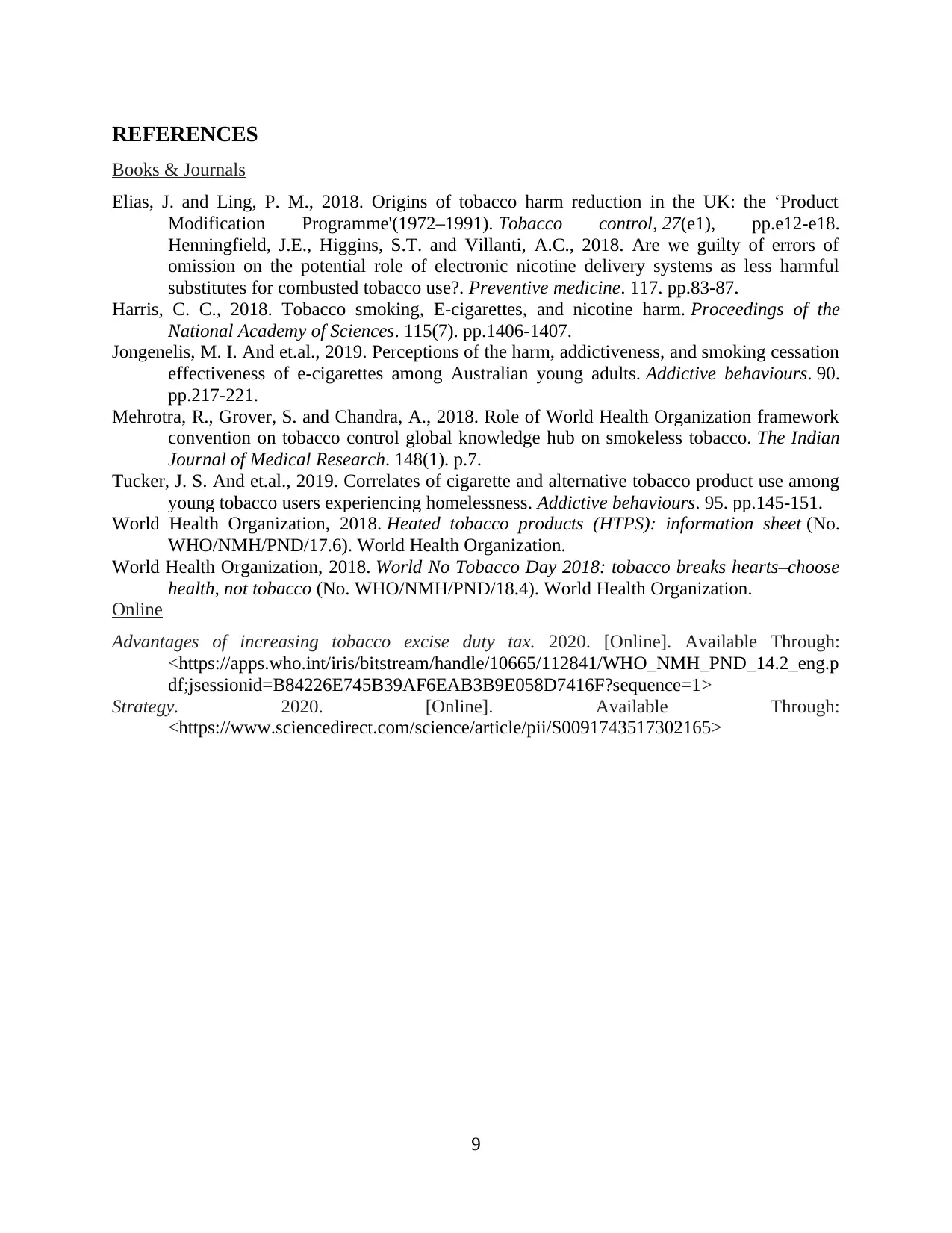
REFERENCES
Books & Journals
Elias, J. and Ling, P. M., 2018. Origins of tobacco harm reduction in the UK: the ‘Product
Modification Programme'(1972–1991). Tobacco control, 27(e1), pp.e12-e18.
Henningfield, J.E., Higgins, S.T. and Villanti, A.C., 2018. Are we guilty of errors of
omission on the potential role of electronic nicotine delivery systems as less harmful
substitutes for combusted tobacco use?. Preventive medicine. 117. pp.83-87.
Harris, C. C., 2018. Tobacco smoking, E-cigarettes, and nicotine harm. Proceedings of the
National Academy of Sciences. 115(7). pp.1406-1407.
Jongenelis, M. I. And et.al., 2019. Perceptions of the harm, addictiveness, and smoking cessation
effectiveness of e-cigarettes among Australian young adults. Addictive behaviours. 90.
pp.217-221.
Mehrotra, R., Grover, S. and Chandra, A., 2018. Role of World Health Organization framework
convention on tobacco control global knowledge hub on smokeless tobacco. The Indian
Journal of Medical Research. 148(1). p.7.
Tucker, J. S. And et.al., 2019. Correlates of cigarette and alternative tobacco product use among
young tobacco users experiencing homelessness. Addictive behaviours. 95. pp.145-151.
World Health Organization, 2018. Heated tobacco products (HTPS): information sheet (No.
WHO/NMH/PND/17.6). World Health Organization.
World Health Organization, 2018. World No Tobacco Day 2018: tobacco breaks hearts–choose
health, not tobacco (No. WHO/NMH/PND/18.4). World Health Organization.
Online
Advantages of increasing tobacco excise duty tax. 2020. [Online]. Available Through:
<https://apps.who.int/iris/bitstream/handle/10665/112841/WHO_NMH_PND_14.2_eng.p
df;jsessionid=B84226E745B39AF6EAB3B9E058D7416F?sequence=1>
Strategy. 2020. [Online]. Available Through:
<https://www.sciencedirect.com/science/article/pii/S0091743517302165>
9
Books & Journals
Elias, J. and Ling, P. M., 2018. Origins of tobacco harm reduction in the UK: the ‘Product
Modification Programme'(1972–1991). Tobacco control, 27(e1), pp.e12-e18.
Henningfield, J.E., Higgins, S.T. and Villanti, A.C., 2018. Are we guilty of errors of
omission on the potential role of electronic nicotine delivery systems as less harmful
substitutes for combusted tobacco use?. Preventive medicine. 117. pp.83-87.
Harris, C. C., 2018. Tobacco smoking, E-cigarettes, and nicotine harm. Proceedings of the
National Academy of Sciences. 115(7). pp.1406-1407.
Jongenelis, M. I. And et.al., 2019. Perceptions of the harm, addictiveness, and smoking cessation
effectiveness of e-cigarettes among Australian young adults. Addictive behaviours. 90.
pp.217-221.
Mehrotra, R., Grover, S. and Chandra, A., 2018. Role of World Health Organization framework
convention on tobacco control global knowledge hub on smokeless tobacco. The Indian
Journal of Medical Research. 148(1). p.7.
Tucker, J. S. And et.al., 2019. Correlates of cigarette and alternative tobacco product use among
young tobacco users experiencing homelessness. Addictive behaviours. 95. pp.145-151.
World Health Organization, 2018. Heated tobacco products (HTPS): information sheet (No.
WHO/NMH/PND/17.6). World Health Organization.
World Health Organization, 2018. World No Tobacco Day 2018: tobacco breaks hearts–choose
health, not tobacco (No. WHO/NMH/PND/18.4). World Health Organization.
Online
Advantages of increasing tobacco excise duty tax. 2020. [Online]. Available Through:
<https://apps.who.int/iris/bitstream/handle/10665/112841/WHO_NMH_PND_14.2_eng.p
df;jsessionid=B84226E745B39AF6EAB3B9E058D7416F?sequence=1>
Strategy. 2020. [Online]. Available Through:
<https://www.sciencedirect.com/science/article/pii/S0091743517302165>
9
1 out of 9
Related Documents
Your All-in-One AI-Powered Toolkit for Academic Success.
+13062052269
info@desklib.com
Available 24*7 on WhatsApp / Email
![[object Object]](/_next/static/media/star-bottom.7253800d.svg)
Unlock your academic potential
© 2024 | Zucol Services PVT LTD | All rights reserved.





